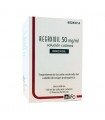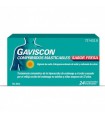Diclofenac diethylamine, the active substance in this medicine, belongs to the group of nonsteroidal anti-inflammatory drugs and acts as an analgesic and local anti-inflammatory. Voltadol is indicated in adults and adolescents over the age of 14 for local relief from mild and occasional pain and inflammation caused by: -small bruises, bumps, strains -torticollis or other contractures -lumbalgias - mild sprains produced as a result of a sprain
ACTION AND MECHANISM
- Anti-inflammatory and topical analgesic. Diclofenac is a non-steroidal anti-inflammatory derived from phenylactic acid, which works by preventing the synthesis of prostaglandins and other prostanoids by inhibiting cyclooxygenase involved in inflammatory processes.
Elderly
The elderly may be especially susceptible to adverse reactions of diclofenac, so it is recommended to use it with caution.
PATIENT ADVICE
- Consult your doctor and/or pharmacist if previous allergic reactions to other anti-inflammatory drugs, including aspirin, have been reported.
- Do not cover the area with occlusive bandages.
- It should not be applied to areas of skin with burns, open wounds, dermatitis or infections.
- Do not expose treated areas to the sun or UVA light sources until at least one day after the last application.
- Consult your doctor and/or pharmacist if symptoms continue or worsen after the days set out in the package leaflet for presentation.
Contraindications
- Hypersensitivity to diclofenac or any other component of the medicinal product. There are communications of cross-allergic reactions between different NSAIDs, as well as salicylates, so it is also not recommended to use diclofenac in case of [INE ALLERGY] or [SALICILATOS ALLERGY].
- In patients who have previously suffered attacks of [ASMA], [URTICARIA] or [RINITIS] caused by acetylsalic acid or other nonsteroidal anti-inflammatory drug (NSAIDs).
- Do not apply to wounds, eczematous lesions, mucous membranes, or burns.
- In children and adolescents under 14 years of age.
- In the third trimester of pregnancy.
- Do not administer concomitantly with other products containing diclofenac
Pregnancy
Animal safety: prenatal, perinatal and postnatal development of progeny was not affected.
Safety in humans: approximately 10% of the topical dose is absorbed systemically with considerably lower bioavailability topically than orally. Adequate and well-controlled human studies with topical diclofenac are not available, but systemic diclofenac has resulted in fetal toxic effects in the final stages of pregnancy. Although skin absorption is minimal, systemic effects cannot be ruled out.
Topical use of diclofenac during the first two trimesters of pregnancy is only accepted if, in the absence of other safer therapeutic alternatives, the benefits outweigh the potential risks.
The use of diclofenac during the third trimester of pregnancy is contraindicated, as diclofenac has been associated with delayed delivery, and cardiopulmonary side effects on the fetus, such as premature closure of ductus arteriosus and pulmonary hypertension, and renal, such as acute renal failure and oligohydramnios. It can also increase bleeding time in the mother.
Fertility effects: there is no evidence that diclofenac has teratogenic potential in mice, rats or rabbits. In humans, preclinical data obtained in acute toxicity studies and repeated doses, as well as in studies of genotoxicity, mutagenesis and carcinogenesis with diclofenac have revealed that there is no specific risk at the expected therapeutic doses.
Pharmacokinetics
Topically:
Indications
- [PAIN]. Symptomatic treatment of acute inflammatory and/or painful processes, such as:
* [CONTUSION] or [ESGUINCE] produced by twists.
Interactions
No interactions have been reported at recommended doses. However, in case of significant systemic absorption, the same interactions could occur as with systemic diclofenac.
In addition, as with any topical treatment, it is not advisable to administer two topical medicines at once on the same area.
Breast feeding
It is not known whether topical diclofenac is excreted with milk, and the consequences it could have for the infant. Approximately 10% of the topically applied dose is absorbed systemically. Systemic Diclofenac is excreted in small amounts with human milk. Manufacturers advise stopping breastfeeding or avoiding breast administration.
Children
See the posology section specifying how old it can be used in children.
RULES FOR PROPER ADMINISTRATION
- It should be applied to healthy and intact skin, without injury or open wounds.
- It is not recommended to cover the area with occlusive bandages.
- Its application should be avoided near the eyes, as well as in mucous membranes.
- After application, your hands should be washed unless they are the place of treatment.
Dosage
"Nice place to stay"
- Adults and adolescents over 14 years: apply a thin layer (2-4 g of gel, equivalent to the size of a cherry or walnut, respectively), 3-4 times a day.
Precautions
- [PHOTOSENSITIVITY REACTIONS]. Diclofenac has resulted in photosensitivity reactions. It is recommended not to expose treated areas to the sun or UV light for at least one day.
- Systemic reactions. The risk of systemic reactions from topical diclofenac is minimal, although it cannot be ruled out if significant systemic absorption occurs, as can happen if applied in damaged areas of skin (dermatitis, burns, wounds) or with an occlusive bandage. It is recommended to follow dosage recommendations in patients with asthma, history of peptic ulcer, renal or cardiac failure, as well as hypertension.
ADVERSE REACTIONS
- Dermatological: Common (1-10%) local reactions in the application area, such as [PRURITO], [SKIN IRRITATION], [ERYTHEMA], [EXANTEMATIC ERUPTIONS], with the appearance of pustules or papules at times.
- Allergic: Uncommon (0.1-1.0%) [HYPERSENSITIVITY REACTIONS], [CONTACT DERMATITIS]; [ANAFILAXIA], [ANGIOEDEMA] and [PHOTOSENSITIVITY REACTIONS].
In case of significant absorption, systemic adverse reactions of diclofenac may occur.
ADVERSE REACTIONS RELATING TO EXCIPIENTS
- This medicine contains propylene glycol, so it may produce [SKIN IRRITATION].
Overdose
Symptoms: Due to its route of administration, symptoms are not very likely to occur in case of overdose, although accidental ingestion or improper application could cause typical systemic side effects.
Treatment: In case of accidental ingestion, stomach washing and symptomatic treatment will be performed.




























